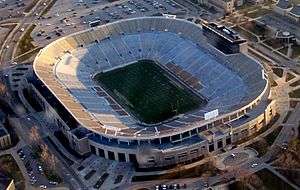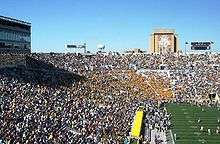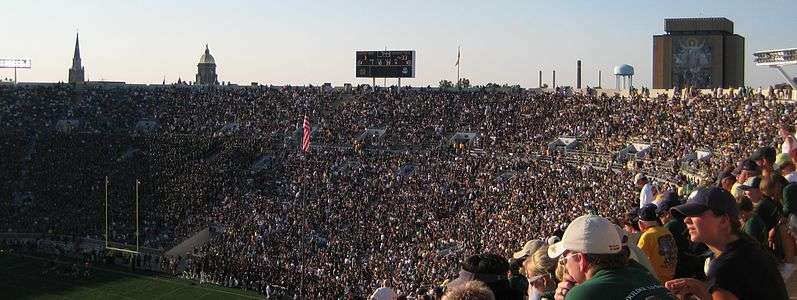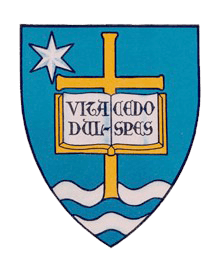Notre Dame Stadium
| The House That Rockne Built | |
 | |
| Location | South Bend, Indiana |
|---|---|
| Coordinates | 41°41′53″N 86°14′02″W / 41.698°N 86.234°WCoordinates: 41°41′53″N 86°14′02″W / 41.698°N 86.234°W |
| Owner | University of Notre Dame |
| Operator | University of Notre Dame |
| Capacity |
80,795 (1997–present) 59,075 (1930–1996) |
| Surface |
FieldTurf (2014–present) Grass (1930–2013) |
| Construction | |
| Broke ground | 1929 (earthwork) |
| Opened |
October 4, 1930 86 years ago |
| Construction cost | $750,000 |
| Architect | Osborn Engineering |
| General contractor | Sollitt Construction Company |
| Tenants | |
|
Notre Dame Fighting Irish (NCAA) (1930–present) | |
The Notre Dame Stadium is an outdoor football stadium in Notre Dame, Indiana, the home field of the University of Notre Dame Fighting Irish. It is located on the university's campus, just north of South Bend.
Opened 86 years ago on October 4, 1930, the stadium seating capacity was nearly 60,000 for decades. More than 21,000 seats were added for the 1997 season, which increased the capacity to over 80,000. The playing surface was changed to FieldTurf in 2014, after 84 seasons on natural grass.
History
The stadium opened its gates on October 4, 1930, replacing Cartier Field. The total cost of construction exceeded $750,000 and the original seating capacity was 54,000. Head coach Knute Rockne played a key role in its design, keeping the space between the playing field and the stands to a minimum. The stadium is patterned, on a smaller scale, after Michigan Stadium, the main difference being the tunnel location. In 1929, plans were started by Osborn Engineering of Cleveland, selected for their experience in designing Yankee Stadium and Fenway Park. The original stadium held 59,075 people, measured a half-mile (800 m) in circumference, stood 45 feet (14 m) high, and featured a glass-enclosed press box rising 60 feet (18 m) above ground level. Initial stands reached 55 rows.[1] The building was built by the Sollitt Construction Company of South Bend. Earth preparation began in the fall of 1929, but due to an unusually cold fall and winter, above ground construction did not begin until April 2, 1930. This building was effectively built in six months. Over two million bricks were used in the construction of the walls and the concrete was placed in a monolithic continuous placement by section. There were over 300 workers on the site at most times and they worked five 10-hour days and one six-hour day on Saturdays. The average worker was paid one dollar a day plus lunch with the more skilled workers earning up to five dollars a day.[2]
.jpg)
The construction of the stadium project was brought to a head by the actions of Knute Rockne. The 1928 season had not been a stellar one for the football team, however the net profits from football for that season approached $500,000. Rockne was frustrated with the slow and cautious Holy Cross priests and their decision making process about spending money on the new stadium. Rockne could not believe that a decision could not be made when there was such a large amount of money in the bank. Because of this and a number of other issues, Rockne submitted his resignation to Father O’Donnell, the president of the university. O’Donnell knew of Rockne’s history of submitting his resignations and he also knew that nothing would ever completely satisfy Rockne. O’Donnell was willing to find a compromise but was also unwilling to put the university in debt to finance the stadium. He knew that the excess receipts from 1928 season and the projected receipts from playing all the away games in 1929 on neutral fields would bring adequate cash into the university to finance the construction of the stadium. O’Donnell also devised the scheme to finance 240 six-person “reserved box seats”. This precursor of the personal seat license would allow the buyer to purchase tickets at face value and guarantee the same prime location for 10 years for an investment of $3,000 between the 45-yard lines, $2,500 between the 45 and 35-yard line and $2,000 between the 35 and the 25-yard line. The university raised over $150,000 on this idea alone.[3]
The Irish played their first game in the new stadium in 1930 on October 4, beating SMU 20–14. The first Notre Dame touchdown in the stadium was scored by "Jumping Joe" Savoldi on a 98-yard kickoff return. The official dedication was a week later on October 11 against Navy, and Savoldi scored three touchdowns and was cited as "the first hero in the lore of Notre Dame Stadium." Over the years, its capacity was gradually increased to 59,075, mainly by changing the average seat width from 18 to 17 inches (45.7 to 43.2 cm). In 1997, 21,000 new seats were added to the stadium, bringing the seating capacity to the present 80,795. The playing surface had always been natural grass through 2013, but it was announced on April 12, 2014, that after the commencement weekend, the playing field would be replaced with FieldTurf, an infilled artificial turf.[4] Notre Dame athletic director Jack Swarbrick, in making the announcement, cited recent difficulties with maintaining an acceptable grass surface, and added that the change would allow the stadium to be used for football practices and non-football events.[4] During 2013, the university replaced the grass surface four times, including twice during the football season.[5]

On January 29, 2014, the university announced plans to attach three new buildings to the stadium, totaling more than 750,000 square feet in expansions and costing about $400 million, with a timetable of 33 months for completion. According to a published statement by university president John I. Jenkins, "the integrated nature of this project will maintain the compact walkability of campus, facilitate deeper connection and collaboration across the various units of the university, and offer an exciting addition" to the campus.[6]
The FieldTurf installation, as scheduled, began after Commencement Weekend on May 16–18, and the university sold 2-by-5-foot (61 by 152 cm) sections of the old turf to the public for $150 each.[5]
Lighting
Prior to the 1997 expansion, Notre Dame Stadium lacked permanent field lights. In 1982, portable lighting by Musco Lighting was used for the first night game in the stadium's history on September 18 versus Michigan. Permanent lights were installed as part of the expansion. The lights were paid for by NBC, which has held the exclusive television rights to all home games since 1991. The permanent lights were added primarily to ensure sufficient lighting for mid-afternoon games in November; the university's agreements with NBC from 1991 to 2010 stipulated that there be no home night games.[7] However, the stadium hosted its first night game in 21 years on October 22, 2011 when the Irish hosted USC.[8] It was announced in 2015 that Musco would be installing a LED field lighting system as part of the 2014-2017 stadium renovation and expansion project. [9]
"Touchdown Jesus"

The stadium is known for its view of "Touchdown Jesus", a nickname given to the large mural entitled The Word of Life by Millard Sheets of the resurrected Jesus.[10] Installed in 1964 on the Hesburgh Library, the mosaic wall looms over the stadium. The mural's nickname is derived from Jesus' upraised arms, which are similar in appearance to the raised arms of a referee signifying a touchdown. The expansion of the stadium in the late 1990s partially obscured the view of the mural from the playing field. The Word of Life mural was a gift of Mr. and Mrs. Howard V. Phalin of Winnetka, Illinois.
Campus Crossroads
In January 2014, the University announced a 400 million dollars enhancement of the Stadium, the Campus Crossroads project. This expansion will feature 3 8-story high buildings, on the South, West and East sides of the stadium. The expansion will add more than 750,000 square feet of teaching, research, and performance space. The enhancement will also add new premium stadium seats.
Attendance
Prior to 1966, attendance figures were based on an actual count of patrons through the gates. The largest crowd to attend a home game prior to expansion was 61,296 in 1962, against Purdue on October 6. Since 1966, attendance figures have been based on sales, paid admissions with a fixed number of tickets available, accounting for the familiar 59,075 figure through the 1996 season. Until Ara Parseghian arrived as coach at Notre Dame in 1964, sellouts were not the norm. Since then, tickets to a Notre Dame football game have been notoriously hard to come by. As of the end of the 2015 season, there have been 249 consecutive sellouts at Notre Dame Stadium, and 294 sellouts in the past 295 games dating back to 1964. The lone exception was a 1973 game against Air Force which had been moved midseason by ABC to Thanksgiving Day and was played with the students absent. The announced attendance was 57,235. Attendance at all five home games in 1965 exceeded 59,000 as well.
The official capacity was listed at 80,225 when the stadium was first expanded. A subsequent computer revision put it at 80,012 in 1998 and 80,232 in 2000. Sideline bleachers, which had been removed during expansion, were put back in after a few years, bringing the figure to its present 80,795 in 2001. In January 2014 the University of Notre Dame announced the campus crossroads project. A $400 million renovation would add luxury boxes and increase the stadium's capacity to around 85,000. The project began after the conclusion of the 2014 football season and is expected to be finished in time for the 2017 season.

References
- ↑ http://stadiumdb.com/news/2015/09/new_stadiums_old_gray_lady_and_others
- ↑ Notre Dame archives
- ↑ Being Catholic, Being American The Notre Dame Story, 1842-1934, Robert E Burns, University of Notre Dame Press, Notre Dame Indiana,1999
- 1 2 "Synthetic Turf to be Installed in Notre Dame Stadium by 2014 Football Season" (Press release). Notre Dame Athletics. April 12, 2014. Retrieved May 19, 2014.
- 1 2 "Notre Dame sells turf for $150". ESPN.com. Associated Press. May 19, 2014. Retrieved May 19, 2014.
- ↑ "Notre Dame Spending $400 Million on Football Stadium Renovation". Article. Newsmax. Retrieved 29 January 2014.
- ↑ http://www.azcentral.com/sports/colleges/articles/2008/06/19/20080619nbcnd.html
- ↑ http://www.und.com/sports/m-footbl/sched/nd-m-footbl-sched.html
- ↑ http://www.musco.com/news/press-nd.html
- ↑ University of Notre Dame Hesburgh Libraries, Hesburgh (Main) Library Word of Life Mural
